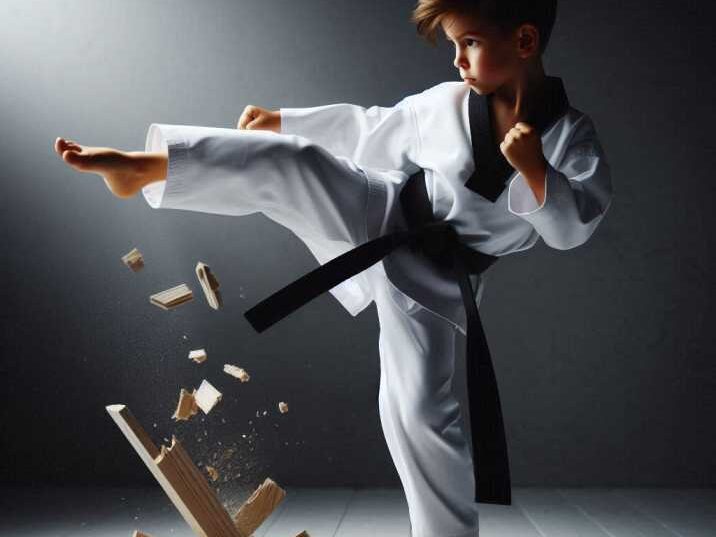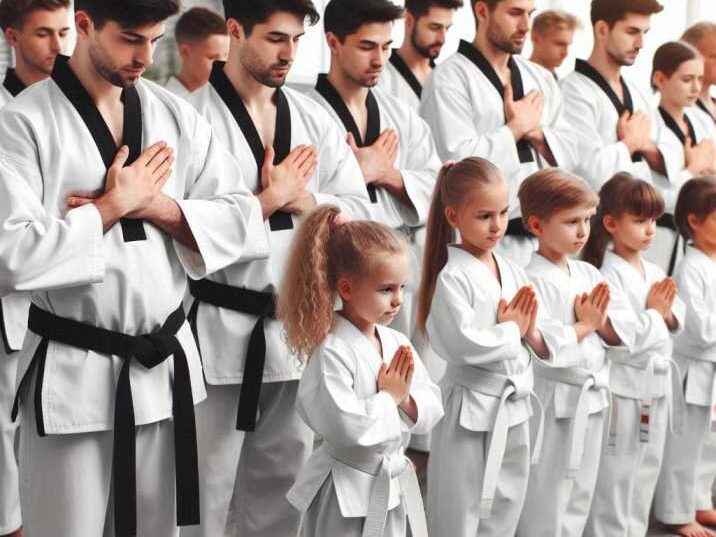Introduction
Table of Contents
Taekwondo is one of the most popular martial arts in the world, known for its powerful kicks, graceful movements, and emphasis on discipline. But have you ever wondered what the word “Taekwondo” really means? In this article, we’ll explore the meaning behind Taekwondo, its origins, and why it’s more than just a martial art. By the end of this article, you’ll understand the true essence of Taekwondo and how it can help you become physically stronger and a better person.

The Meaning of Taekwondo
The word “Taekwondo” comes from three Korean words: “Tae,” “Kwon,” and “Do.” Each part of this word gives clues about the martial arts’s purpose and practice.
1. Tae (태) – Foot or Kick
The word “Tae” refers to using the feet in Taekwondo. This is one of the most important aspects of the martial art, as Taekwondo is famous for its incredible kicks. Practitioners use their legs to perform fast and powerful kicks, showing speed and accuracy. Tae emphasizes the art of using the foot to defend oneself or attack.
2. Kwon (권) – Fist or Punch
The second part of the word, “Kwon,” refers to the fist. This focuses on using the hands to punch and block. In Taekwondo, students learn to use their hands to strike with precision and power. Just like with kicking, there is an art to learning how to use your fists properly.
3. Do (도) – The Way or Path
Finally, the word “Do” means “the way” or “the path.” This part of Taekwondo is not about fighting but the journey of self-improvement, discipline, and respect. It teaches that Taekwondo is not just about physical movements; it’s also about becoming a better, more respectful person.
“Taekwondo” can be translated as “The Way of the Foot and the Fist.” It combines the physical skills of kicking and punching with a deeper philosophy of self-control, discipline, and respect for others.
A Brief History of Taekwondo
Taekwondo originated in Korea over 2,000 years ago. It was initially practiced as a form of defense to protect against invaders. Over time, it developed into a structured martial art practiced worldwide.
In the 1950s, after the Korean War, General Choi Hong Hi helped modernize Taekwondo and spread it globally. Today, Taekwondo is not just a martial art; it’s also a sport, with competitions held worldwide. In fact, it became an official Olympic sport in 2000.
The Principles of Taekwondo
Taekwondo is built on five main principles. These principles guide students in their training and life. Each one is essential for understanding the meaning of Taekwondo beyond the physical movements.
1. Courtesy
Being polite and respectful to others is a key principle in Taekwondo. Students are taught to greet their teachers, respect their peers, and always have good manners.
2. Integrity
Integrity means always doing what is right, even when no one is watching. In Taekwondo, integrity is about honesty and standing up for what you believe is right.
3. Perseverance
Perseverance means never giving up, even when things are hard. In Taekwondo, students learn to keep practicing and pushing forward, no matter the challenge’s difficulty.
4. Self-Control
Taekwondo teaches students to control their actions, both in and out of class. Self-control is essential for making good decisions and managing your emotions.
5. Indomitable Spirit
An indomitable spirit means having courage and determination that cannot be broken. This principle reminds students to stay strong, no matter their life challenges.
Taekwondo as a Sport
Taekwondo is not only a martial art; it’s also an exciting sport! Competitions are held worldwide, where athletes demonstrate speed, strength, and technique. In a typical Taekwondo match, athletes earn points for landing kicks and punches on their opponent. However, the sport is also about showing good sportsmanship and respect for your competitor.
Benefits of Practicing Taekwondo
Taekwondo offers many benefits for the body and the mind. Here are some key advantages:
1. Physical Fitness
Taekwondo is a great workout. It improves your strength, balance, and flexibility. The constant movement helps build strong muscles and improve your overall fitness.
2. Discipline
The structure and rules of Taekwondo teach students discipline. Whether bowing to your teacher or following instructions, Taekwondo helps students develop self-discipline.
3. Confidence
As students improve at Taekwondo, they become more confident in their abilities. Learning new skills and mastering difficult techniques gives a sense of achievement.
4. Respect
Respect is a huge part of Taekwondo. Students learn to respect their teachers, peers, and even their opponents. The respect they develop in class carries over into everyday life.

5. Self-Defense
Taekwondo also teaches practical self-defense techniques. Students gain confidence and feel safer daily by learning how to protect themselves.
Table of Information: Taekwondo Means
| Term | Meaning |
|---|---|
| Tae | Foot or kick |
| Kwon | Fist or punch |
| Do | The way or path |
| Courtesy | Being polite and respectful |
| Integrity | Doing what is right, even when alone |
| Perseverance | Never giving up |
| Self-Control | Controlling your actions and emotions |
| Indomitable Spirit | Courage that cannot be broken |
Conclusion
What does taekwondo mean? Taekwondo is much more than just kicks and punches. It’s a martial art that teaches discipline, respect, and self-improvement. By understanding the meaning behind the word Taekwondo, students can appreciate the physical skills and the life lessons it offers. Whether you want to improve your fitness, gain confidence, or learn self-defense, Taekwondo can help you become the best version of yourself.
FAQs About Taekwondo
1. What is the meaning of Taekwondo?
Taekwondo means “The Way of the Foot and the Fist,” focusing on kicks, punches, and self-discipline.
2. Where did Taekwondo originate?
Taekwondo originated in Korea over 2,000 years ago as a form of self-defense.
3. Is Taekwondo an Olympic sport?
Yes, Taekwondo became an Olympic sport in 2000.
4. What are the benefits of practicing Taekwondo?
Taekwondo improves physical fitness, discipline, confidence, and respect and teaches self-defense.
5. What are the five principles of Taekwondo?
The five principles are courtesy, integrity, perseverance, self-control, and indomitable spirit.


